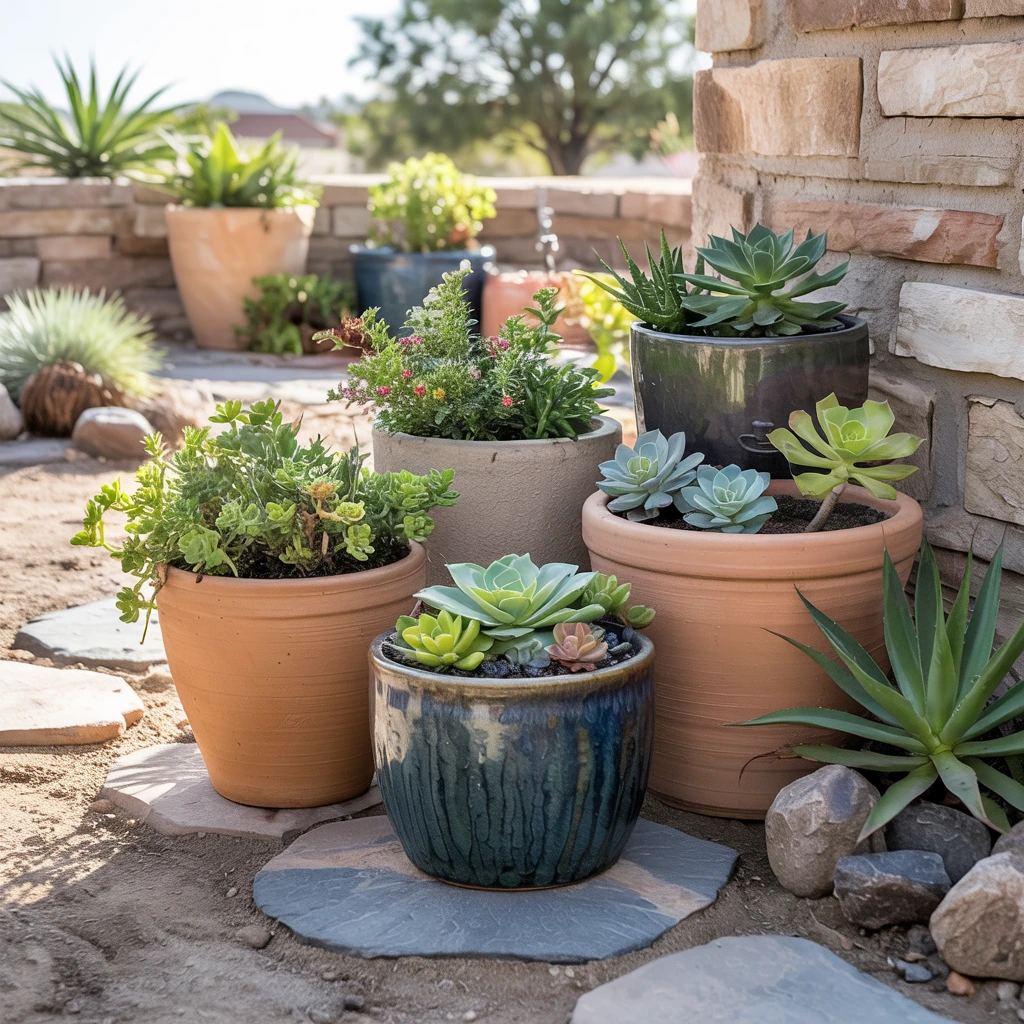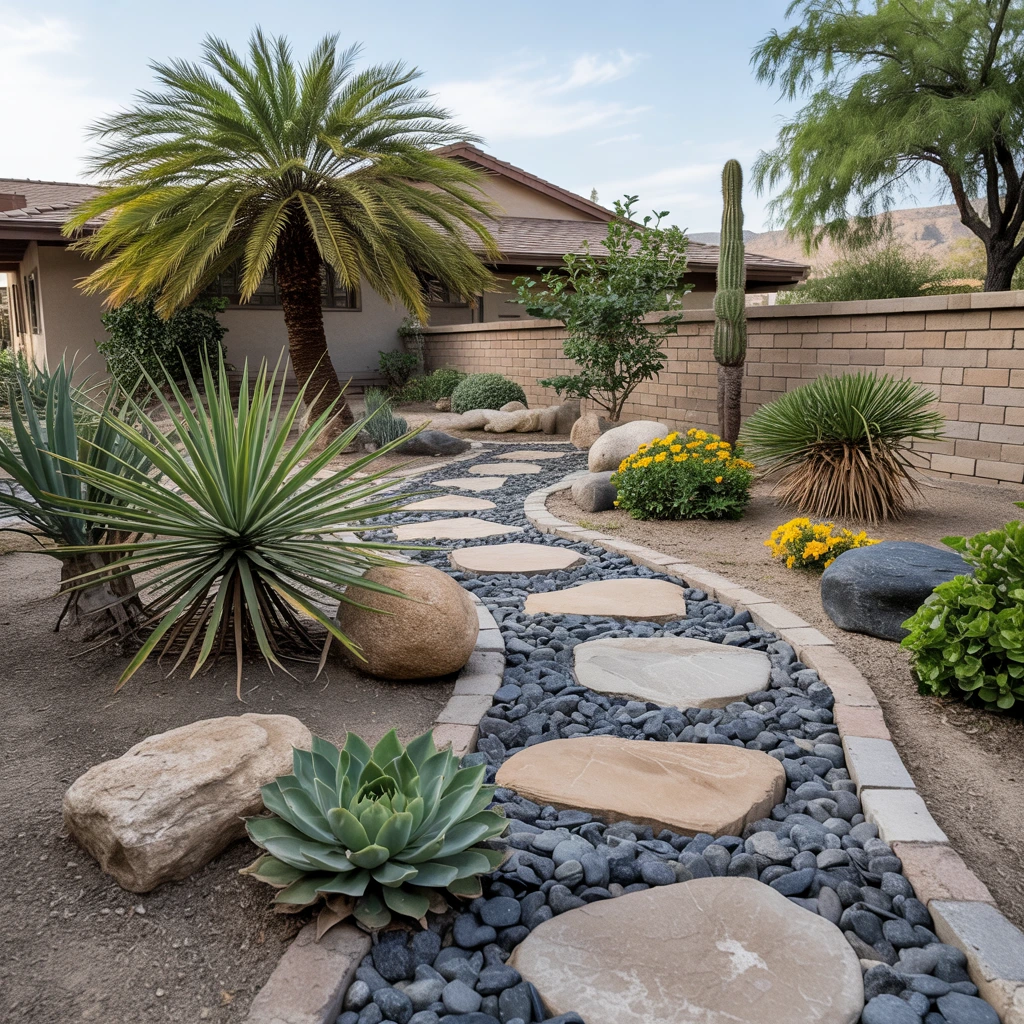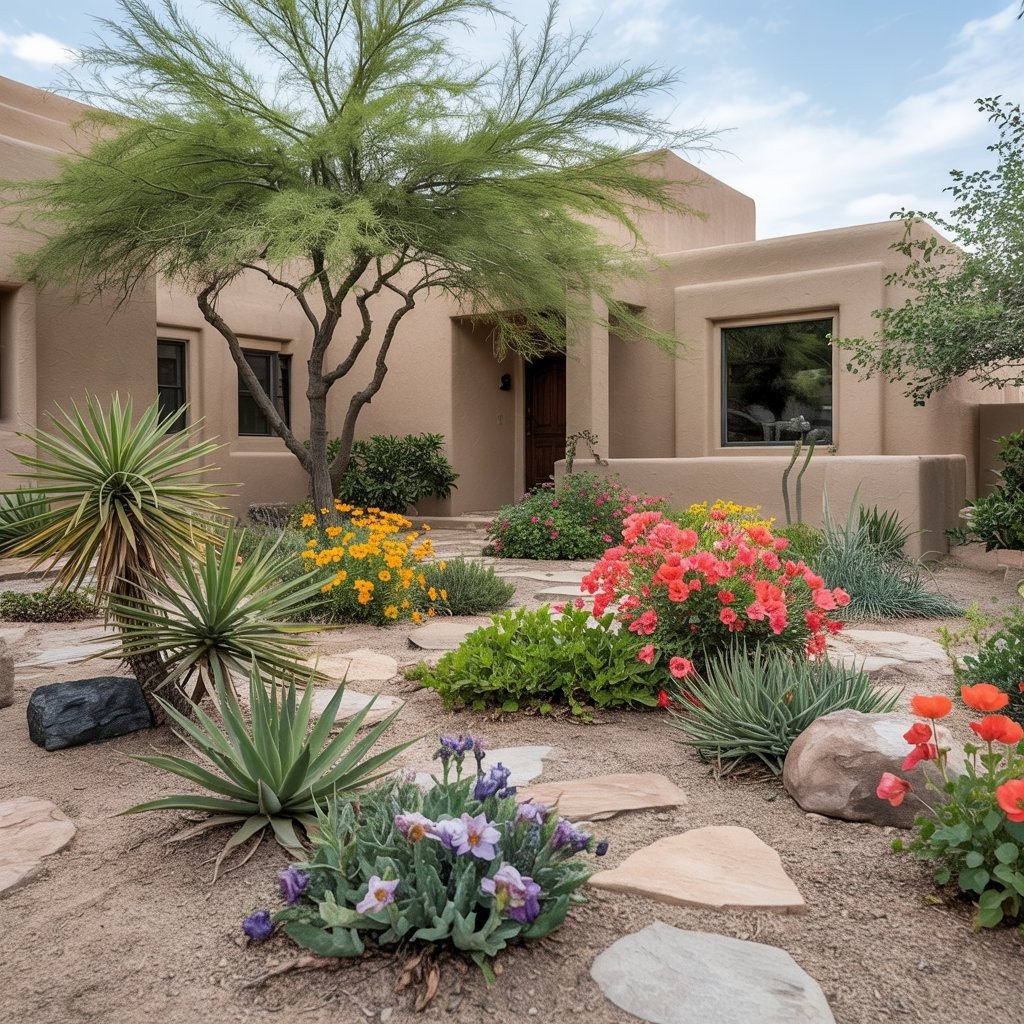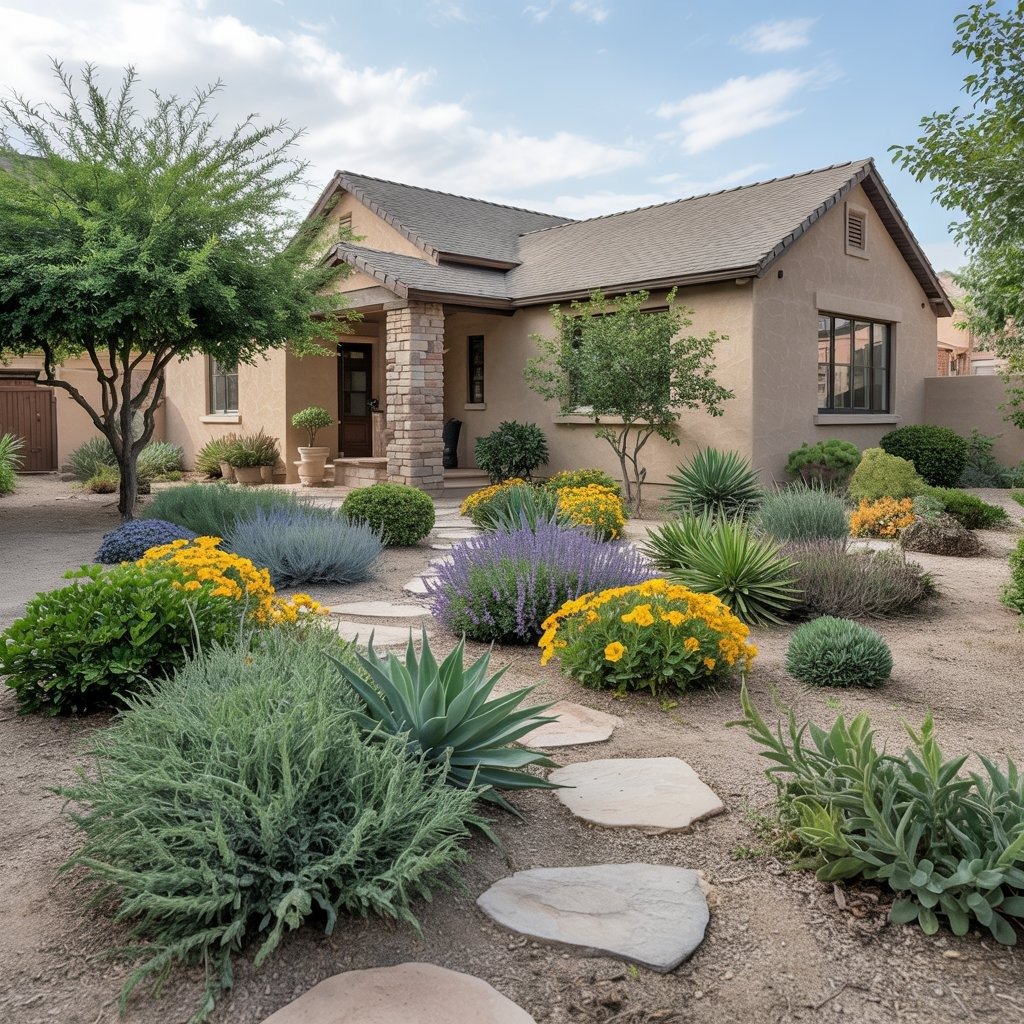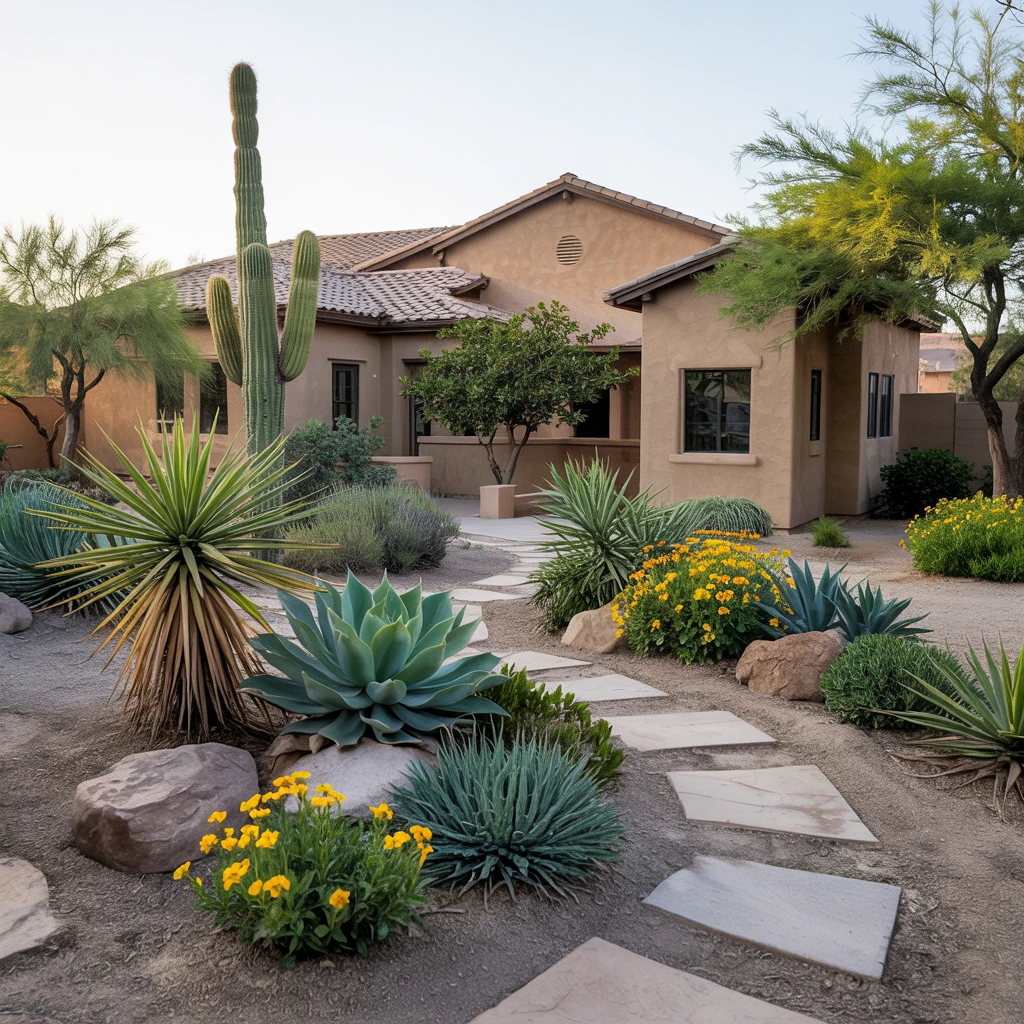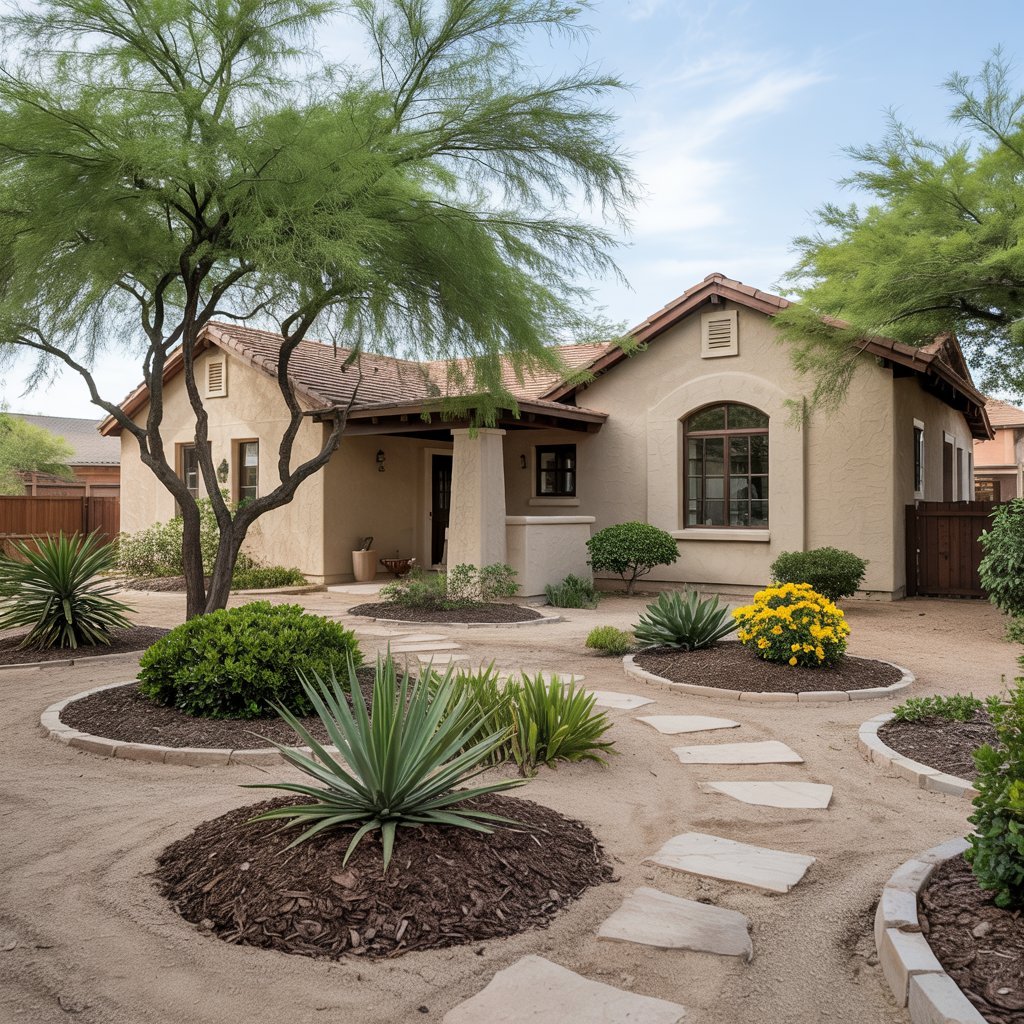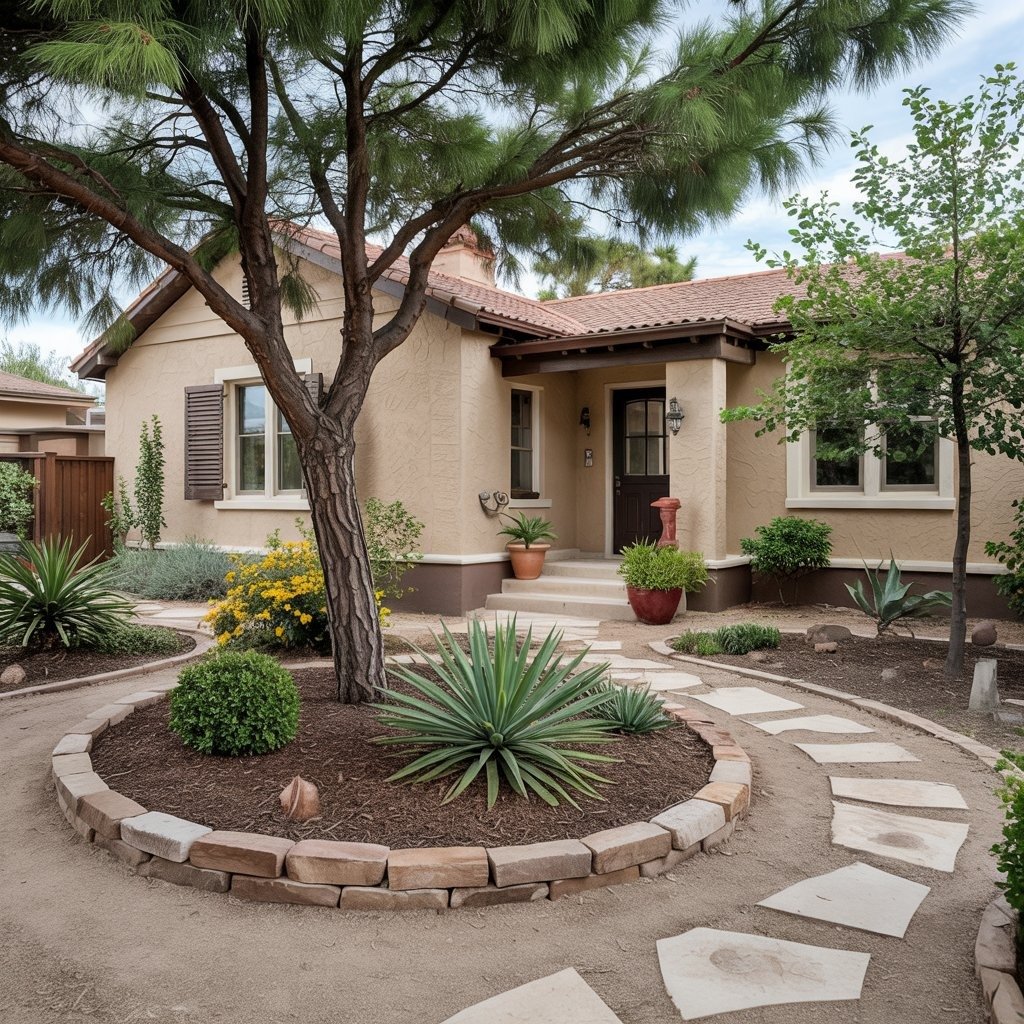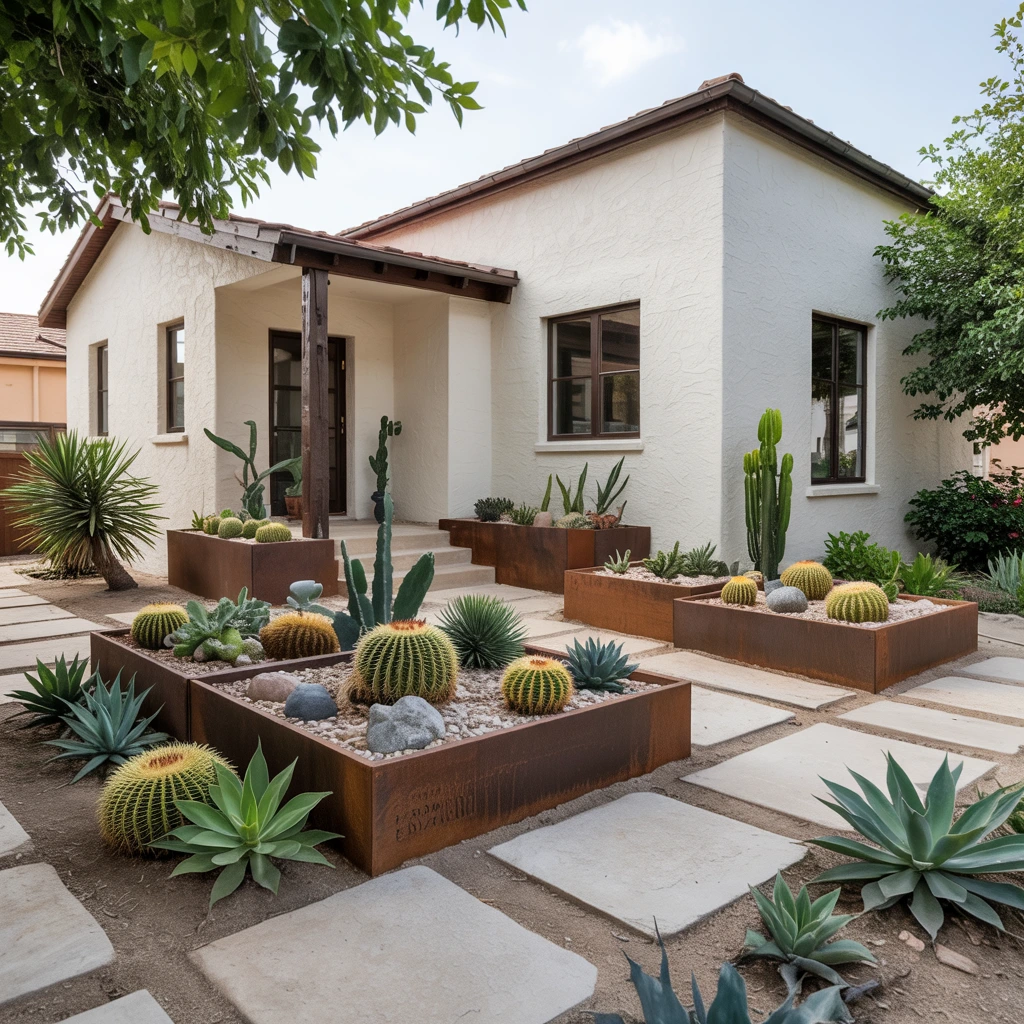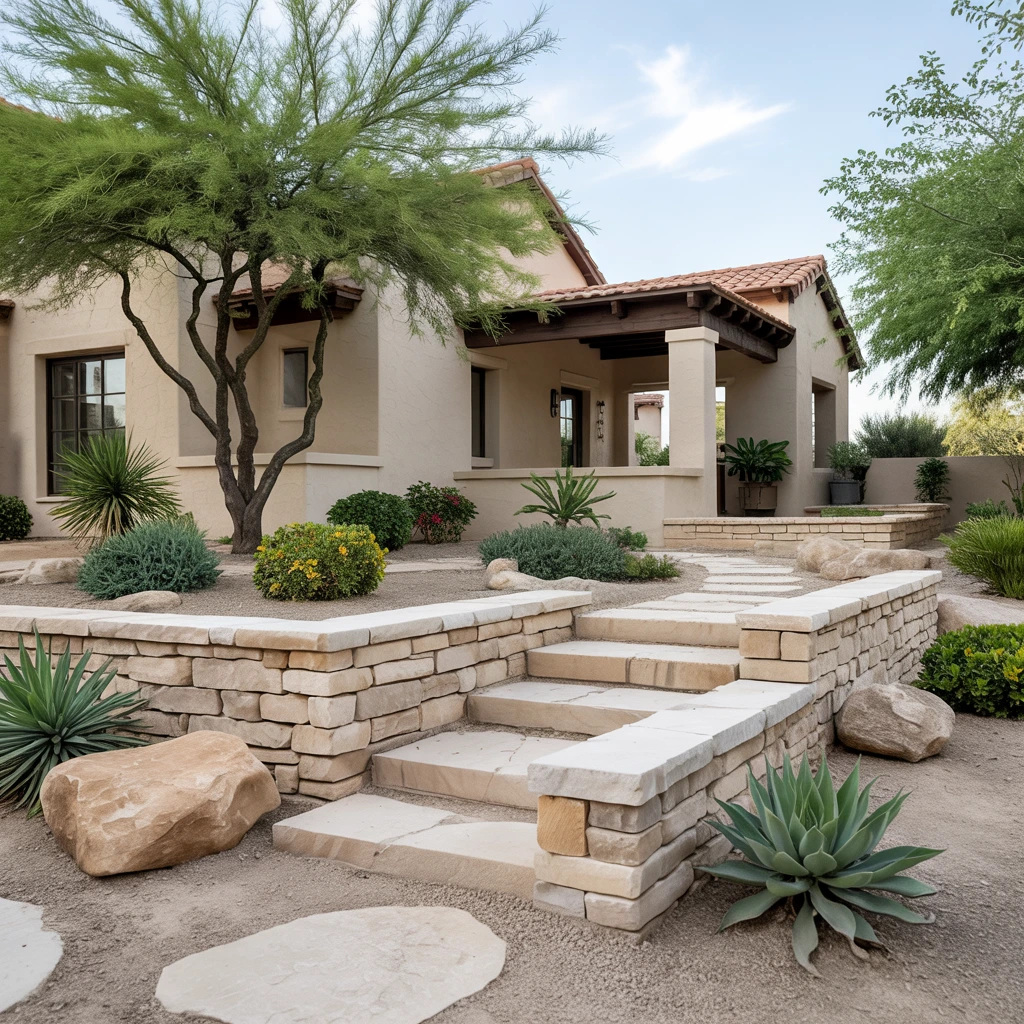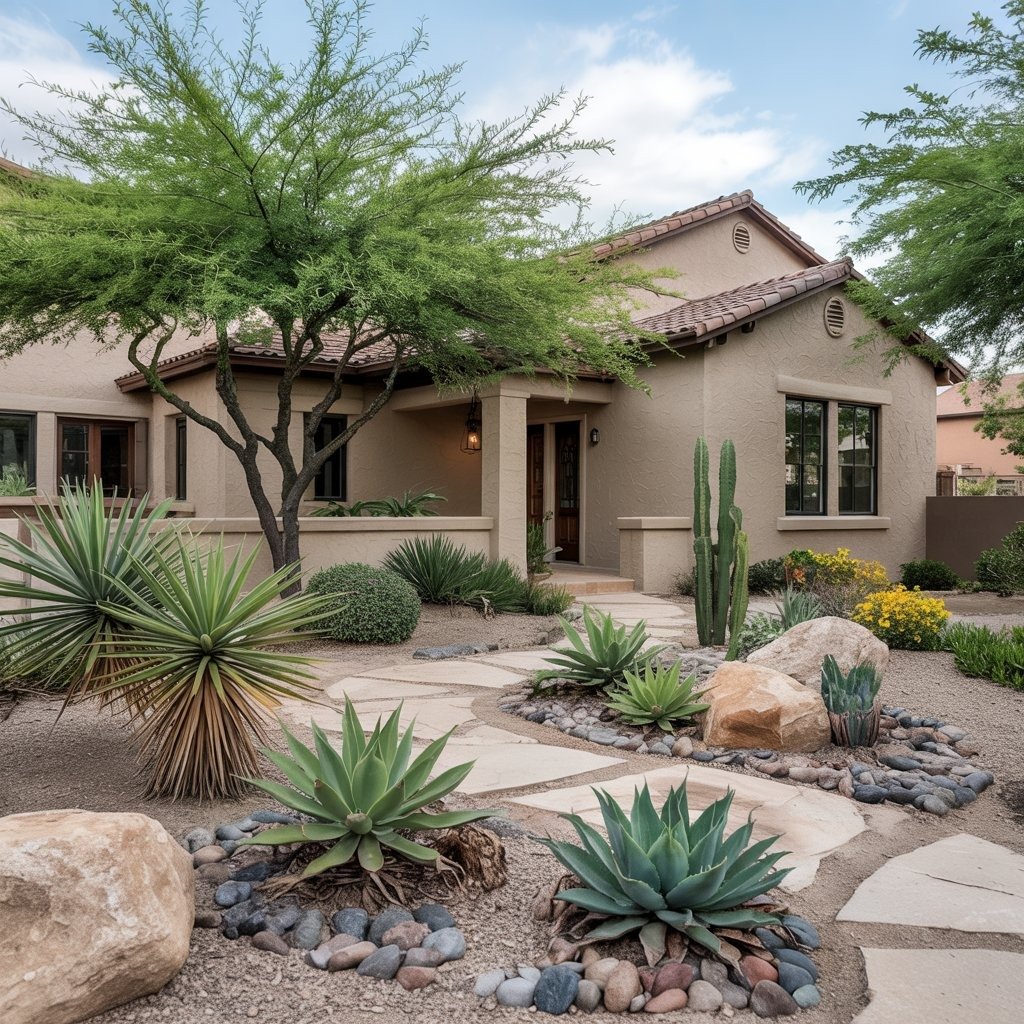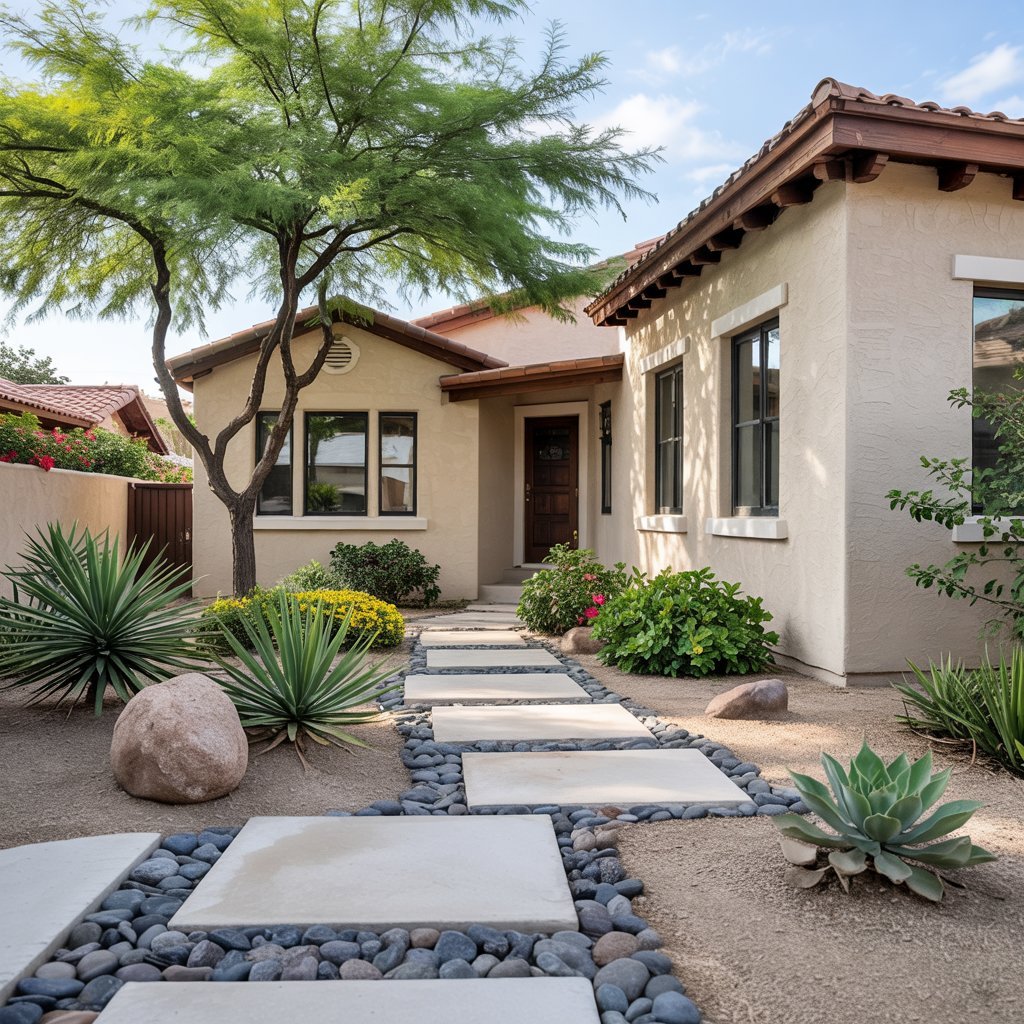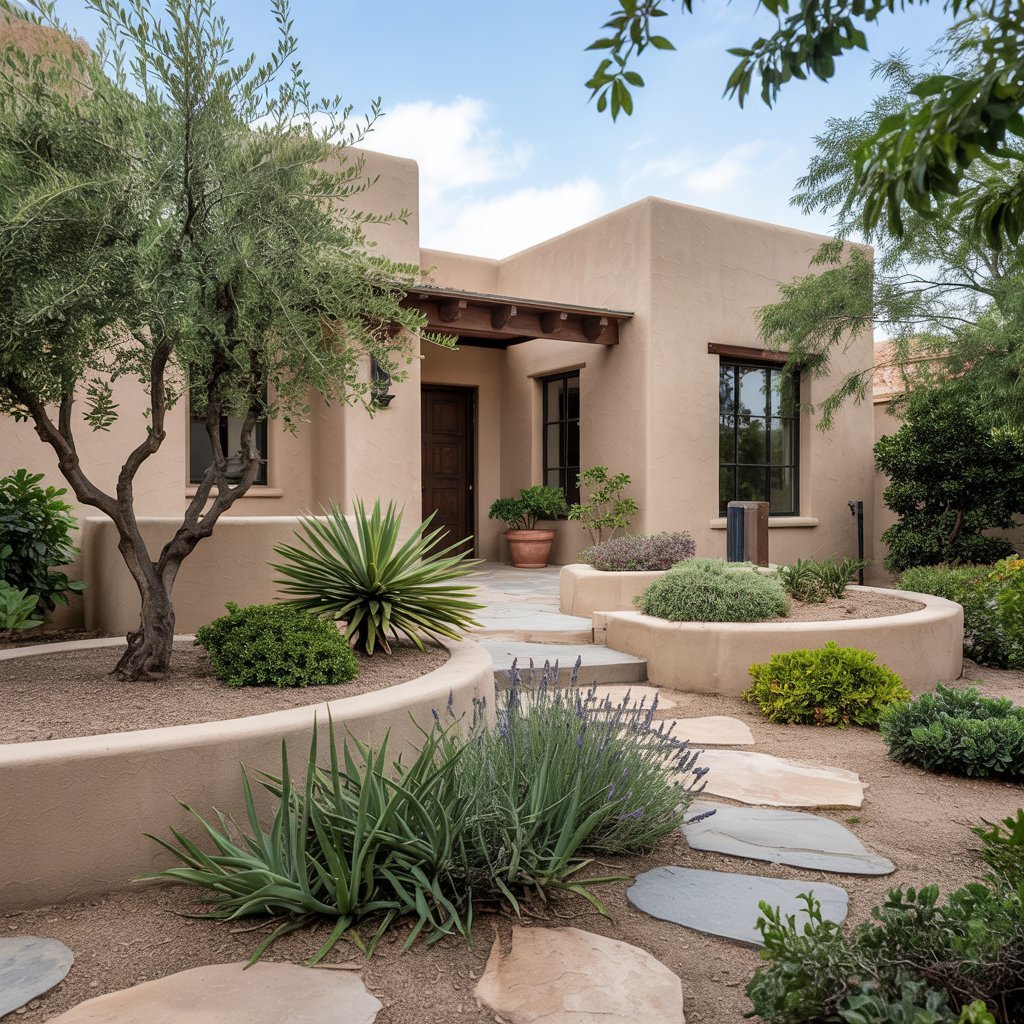20 Desert Landscaping Ideas That Will Transform Your Outdoor Space
Creating a stunning desert landscape doesn’t mean sacrificing beauty for water conservation. I’ve discovered that the right combination of drought-tolerant plants, strategic hardscaping, and thoughtful design can create an outdoor oasis that’s both environmentally conscious and visually striking.
Desert landscaping offers unique opportunities to embrace bold textures, dramatic shapes, and a palette inspired by nature’s most resilient environments.
Whether you’re dealing with sandy soil, limited water resources, or simply want a low-maintenance yard that makes a statement, these ideas will help you create a landscape that thrives in arid conditions while adding serious curb appeal to your property.
1. Embrace a Desert Color Palette
I always start my desert landscape designs by focusing on the natural color story of arid environments. The classic desert palette features warm terracotta and sandy tones paired with cool blues, grays, greens, and purples.
I like to integrate these colors through both hardscaping elements and plant selections. Adding bright yellow or red accents draws the eye and creates visual interest. Consider using cobalt-blue glazed pots as focal points, or incorporate colorful stones throughout your design for subtle pops of color.
2. Plant Dramatic Agaves as Statement Pieces
I’ve found that agaves make incredible focal points in desert gardens due to their architectural form and striking presence. These fleshy blue-leaved succulents create dramatic statements with their large size and chunky foliage.
Their pale blue and silvery hues perfectly complement the desert aesthetic while being incredibly heat and drought-tolerant. I recommend placing them strategically where their sculptural qualities can be fully appreciated, such as near entryways or as centerpieces in planting beds.
3. Create Container Gardens for Flexibility
I love using container gardening in desert landscapes, especially when dealing with sandy, dry, or rocky soil conditions. Containers give you incredible flexibility for creative designs and allow you to control soil conditions more precisely.
Terracotta pots offer warm tones that beautifully complement succulents’ greens, grays, and blues. Glazed ceramic pots provide more color options and conserve water better than unglazed alternatives. I always recommend watering container plants in late afternoons for maximum water conservation.
4. Incorporate Dry Stream Beds for Function and Beauty
I design dry stream beds not just for their visual appeal, but for their practical water management benefits. They help prevent runoff and conserve water while working beautifully with naturally occurring slopes or gullies.
These features add movement and interest to your landscape even when dry. I use various sized stones to create realistic-looking water channels that guide the eye through the garden and provide excellent drainage during occasional rainfall.
5. Use Gravel and Stone for Textural Contrast
I incorporate rocks and gravel strategically because they allow rainwater to absorb into soil instead of creating runoff. Larger stones look particularly attractive next to the pointed and spiky shapes of desert plants.
Rounded river rock provides beautiful textural contrast against angular plant forms. When creating walking surfaces, I always choose gravel or stone over mulch since it looks more natural in desert landscapes and requires less maintenance.
6. Add Native Wildflowers for Seasonal Color
I plant wildflowers throughout desert gardens to add bursts of seasonal color that complement the permanent plant structure. The coral plant, also known as fountainbush, produces bright red, lacy flower sprays for weeks.
Other vibrant Southwest natives I recommend include Mexican gold poppies, desert mallow, and desert rose. These varieties grow easily from seeds and provide stunning color displays while requiring minimal water once established.
7. Design with Drought-Tolerant Perennials
I select flowering perennials that thrive in desert conditions to create year-round interest without excessive water needs. Russian sage, sedums, and agastache provide beautiful blooms and interesting foliage textures.
Mediterranean herbs like rosemary and lavender offer both culinary value and landscape beauty. Various salvia species and fountain grass add movement and color while being perfectly adapted to arid conditions.
8. Install Artificial Turf for Low-Maintenance Green Space
I recommend artificial turf as a practical alternative to traditional lawns in desert climates. Conventional grass requires enormous amounts of water and constant maintenance in arid environments.
Modern artificial turf looks increasingly realistic and eliminates the need for watering, fertilizing, and frequent mowing. This option works particularly well for areas where you want some green softness without the water demands of natural grass.
9. Build Ascending Walls for Visual Drama
I create low, ascending walls using natural stone or contemporary materials to add visual tension and energize entry experiences. These 30-inch-thick walls can be curved to soften harsh angles.
Juxtaposing curving walls with more masculine, ascending planes creates interesting architectural elements. I often lead visitors along paths past these features to create a sense of journey through the landscape.
10. Plant Closely Together to Maximize Water Efficiency
I group plants with similar water needs together and plant them closer than you might in other climates. This technique maximizes water use efficiency since desert heat makes water evaporate quickly.
Native plants particularly benefit from this approach since they’re adapted to compete for limited resources. Close planting also creates microclimates that help retain soil moisture and provide mutual protection from harsh sun and wind.
11. Amend Desert Soil for Better Plant Health
I always improve sandy desert soil by adding organic compost, which provides essential nutrients and helps roots access available water more effectively. Desert soils often lack the organic matter plants need to thrive.
Trees and shrubs benefit significantly from wood-chip mulch coverings that prevent moisture evaporation and suppress weeds. This soil preparation step is crucial for establishing healthy, long-lasting plantings in challenging desert conditions.
12. Create Sculptural Plant Combinations
I design contemporary combinations that highlight the sculptural qualities of desert plants. Mixing different textures, heights, and forms creates dynamic visual compositions that change throughout the day as light shifts.
Consider pairing spiky cacti with rounded succulents, or combining fine-textured grasses with broad-leaved agaves. These combinations emphasize the dramatic, simple shapes that make desert landscaping so compelling.
13. Install Strategic Landscape Lighting
I add landscape lighting to enhance the dramatic shapes and textures of desert plants after dark. Uplighting agaves and cacti creates stunning shadow patterns on walls and pathways.
Path lighting ensures safe navigation while highlighting the unique beauty of your desert garden at night. LED fixtures work best since they produce less heat and use minimal energy in already warm climates.
14. Use Natural Cedar or Pine Mulch Around Trees
I apply natural mulch around small trees and shrubs whose root systems benefit from insulation and moisture retention. Cedar or pine mulch works well in desert climates and costs less than stone alternatives.
This organic mulch gradually breaks down to improve soil structure while protecting roots from temperature extremes. It’s particularly valuable for newly planted trees that haven’t yet established extensive root systems.
15. Design Mexican Fence Post Cactus Features
I use Mexican Fence Post cactus to add both elegance and humor while optimizing space efficiently. These tall, columnar cacti create vertical interest without requiring much ground space.
They work particularly well along driveways or property boundaries where you want screening that doesn’t block views entirely. Complement these architectural plants with natural materials like beach pebbles or decomposed granite.
16. Create Modular Planter Installations
I design 3D modular installations using contemporary planters filled with low-maintenance cacti and succulents. CorTen steel planters work particularly well in narrow spaces like side yards.
These installations can be arranged and rearranged to create different compositions over time. They’re perfect for renters or anyone who wants flexibility in their landscape design.
17. Build Limestone Walls and Planters
I construct 8-inch thick drystack limestone walls and planters to handle elevation changes while ensuring structural integrity. These walls provide excellent drainage and natural thermal mass.
Accent these installations with oversized boulders and natural stone slabs for steps and visual break points. The limestone weathers beautifully and complements both contemporary and traditional design styles.
18. Plant Texas Native Botanical Designs
I create dramatic streetscape plantings using Texas native plants with local river rock as top dressing. This approach ensures plants are perfectly adapted to local climate conditions.
Native plants require less water, fertilizer, and pest control while providing habitat for local wildlife. The river rock mulch prevents weed growth while allowing water to penetrate to plant roots efficiently.
19. Install Concrete Paver Systems
I use large concrete pavers (2′ x 2′) combined with Mexican beach pebble and river rock mulch for minimal maintenance surfaces. This combination works well in both contemporary and traditional settings.
Adding synthetic lawn areas provides green space without water requirements. Drip irrigation systems ensure efficient water delivery directly to plant root zones, minimizing waste and maximizing plant health.
20. Design Mediterranean Desert Combinations
I blend Mediterranean and desert plant palettes to create unique landscapes that combine the best of both styles. This approach works particularly well with Spanish and contemporary architecture.
Plants like olive trees, rosemary, and lavender from Mediterranean climates pair beautifully with native desert species. This combination provides year-round interest while maintaining low water requirements and minimal maintenance needs.
Conclusion
Transform your outdoor space into a stunning desert oasis that celebrates the natural beauty of arid landscapes while conserving water and reducing maintenance.
Start with one or two of these ideas that resonate most with your space and style, then gradually expand your design as you discover what works best in your specific environment.



